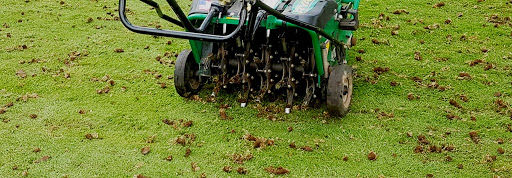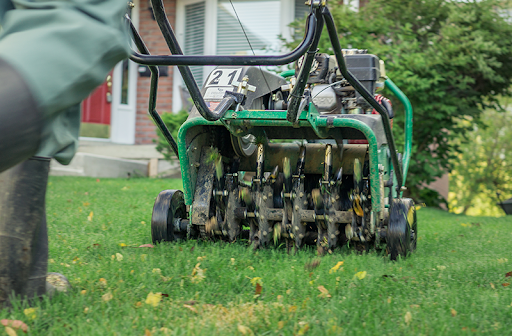Lawn Aerator
Date: 24 Nov 2022
Aeration of Your Lawn is an Important Process to do on a Yearly Basis
Core aeration can help make your lawn healthier and reduce its maintenance requirements through these means, Enhanced soil water uptake. Improved fertilizer uptake and use. Aeration of your lawn allows oxygen to get down to the root level of the grass and it also brakes up the soil to allow water and nutrient to get down to the roots of the lawn.
As New Zealand soils are prone to compact and to become hydrophobic. Hydrophobic soils do not absorb water or nutrients as well as healthy soils do and they do not support grass growth and commonly turns to dust. By Aeration your lawn you will promote growth and will allow nutrients to get down to the roots.

What is Aeration?
Aeration involves perforating the soil with small holes to allow air, water and nutrients to penetrate the grass roots. This helps the roots grow deeply and produce a stronger, more vigorous lawn.
The main reason for aeratingis to alleviate soil compaction. Compacted soils have too many solid particles in a certain volume or space, which prevents proper circulation of air, water and nutrients within the soil. Excess lawn thatch or heavy organic debris buried under the grass surface can also starve the roots from these essential elements.
Should You Be Aerating Your Lawn?
One of the most common questions from homeowners is how to determine if they should be aerating their lawn. Your lawn is probably a good candidate for aeration if it:
- Gets heavy use, such as serving as the neighborhood playground or racetrack. Children and pets running around the yard contribute to soil compaction.
- Was established as part of a newly constructed home. Often, the topsoil of newly constructed lawns is stripped or buried, and the grass established on subsoil has been compacted by construction traffic.
- Dries out easily and has a spongy feel. This might mean your lawn has an excessive thatch problem. Take a shovel and remove a slice of lawn about four inches deep. If the thatch layer is greater than one-half inch, aeration is recommended.
- Was established by sod, and soil layering exists. Soil layering means that soil of finer texture, which comes with imported sod, is layered over the existing coarser soil. This layering disrupts drainage, as water is held in the finer-textured soil. This leads to compacted conditions and poor root development. Aerating breaks up the layering, allowing water to flow through the soil more easily and reach the roots.
When to Aerate Your Lawn
The best time for aeration is during the growing season, when the grass can heal and fill in any open areas after soil plugs are removed. Ideally, aerate the lawn with cool season grass in the early spring or fall and those with warm season grass in the late spring.
Aerating Tools: Plug Aerator vs. Spike Aerator
Two main aerating tools exist — a spike aerator and a plug aerator. With a spike aerator, you simply use the tool to poke holes into the ground with a solid tine, or fork. Plug aerators remove a core or plug of grass and soil from the lawn. For the best results, use an aerating tool or machine that actually removes plugs of soil. Poking holes is less effective and can actually cause additional compaction in the areas around the holes.
Look for an aerating tool or machine that removes soil plugs approximately 2 — 3 inches deep and 0.5 — 0.75 inches in diameter, and about 2 — 3 inches apart. These machines can be rented from lawn and garden stores or home improvement centers. Always follow the directions provided by the store. You may want to consider sharing the rental cost with a neighbor who is interested in aerating the lawn.
How to Aerate Your Yard
If you’re convinced that your lawn is in need of aeration, here are some lawn care tips on how to do it:
- Before you get started, make sure the soil is moist enough. There’s nothing more frustrating than trying to aerate soil that is bone dry. Aerating the day after a rain shower or watering your lawn the day before is advised.
- Most aeration machines cover only a small percentage of soil surface per pass, so make multiple passes over the most compacted areas. Save resources (and your energy) by leaving unaffected areas alone
- The excavated soil plugs should be allowed to dry and then broken up to give your lawn a uniform, clean appearance. Break them up by running them over with a lawnmower or pounding them with the back of a rake. (Your lawn mower blade may need to be sharpened after breaking up the plugs.)
- An aeration myth is that if you apply a pre-emergent herbicide on your lawn in the spring, aerating your lawn will destroy the herbicide “barrier.” This is not true — research shows that aeration will not affect crabgrass control or weed prevention.
- After aerating, it’s important to continue basic lawn care practices such as proper fertilizing, mowing, and watering.
Aeration is a beneficial practice toward achieving a beautiful lawn, but most people don’t realize it or understand the process. If your lawn is a candidate, make it an integral part of your lawn care regime. Your lawn will thank you for letting it breathe again.

